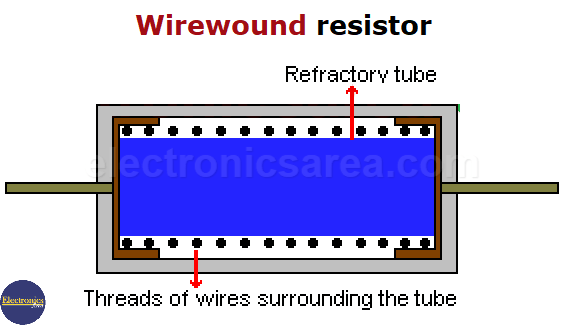What is a wirewound resistor?
A wirewound resistor is a resistor made with a conductive wire of high resistance. This wire is made of a special alloy and is wound on a support tube made of refractory material such as ceramic, porcelain, etc.
Note: A refractory material doesn’t allow heat to pass through it reflects it. The value of a wire wound resistor is determined by the cross section of the wire, its length, and the resistivity of the alloy.
Why use a wirewound resistor?
Wirewound resistors are most commonly used when the power to be dissipated is very high. After the resistor is manufactured, it is usually coated with a layer of vitreous enamel.
The longer the wire and the larger the cross section, the greater the heat radiating surface and the greater the power dissipating capacity.
This type of resistor can be compared to the filament of an incandescent lamp, where power is converted to heat (in an incandescent lamp, this power is converted to light and heat).
Wire wound resistor values and power
Wirewound resistors are manufactured with values up to about 100 kilohms. This is due to physical dimensional issues. The goal is to get the most heat dissipation in the least amount of space. Wire wound resistors can typically dissipate from 5 watts to 100 watts or more.
The picture above shows a blue refractory tube and threads of wires surrounding it. The black dots represent the wires going in and out of the screen, forming a coil of very tight spring around the tube.
Wire wound resistors are available in fixed and adjustable versions for use as rheostats or potentiometers.
Olli Niemitalo, CC0, via Wikimedia Commons
Types of wire wound resistors
Wirewound Resistors for Precision Applications
These wirewound resistors are precision resistors because they are made with a wire whose characteristics are known and a very precise resistance value can be obtained.
This type of wirewound resistor has applications in instrumentation. They are often found in multimeters and calibration equipment. Some wire wound resistors have tolerances as low as 0.005%. The power dissipated by this type of resistor is very low.
Power Wirewound Resistors
This type of resistor can dissipate a large amount of power. Some of them have a heat sink to dissipate even more heat.
Additional Features of Wirewound Resistors
- Its construction allows it to be designed to have any value.
- It is very stable over time. Ordinary resistors change their value over time. This type of resistor is very stable over time because of the material it is made of.
- It has great stability against temperature changes. This is achieved by using a wire with a low temperature coefficient of resistance in its manufacture.
- It has the ability to withstand large voltage spikes for short periods of time without being damaged and without changing its resistance value.
More resistor tutorials
- Resistors in Series – The Equivalent Resistance
- Resistors in parallel (Equivalent resistor value)
- Resistors in parallel (Equivalent resistor value)
- Series/Parallel Resistor Reduction
- What is Electrical Resistivity?
- Resistor Tolerance. What is it? – Color code
- Temperature effect on resistance
- What is Electrical Resistance? Obtaining a material’s resistance
- Wirewound Resistor
- LDR – Photoresistor






